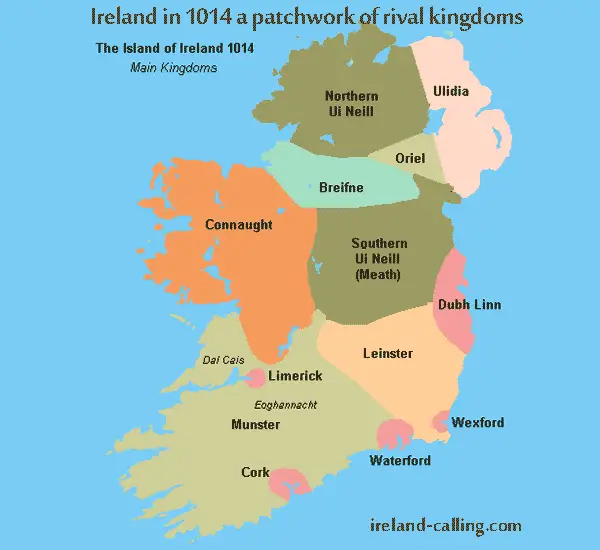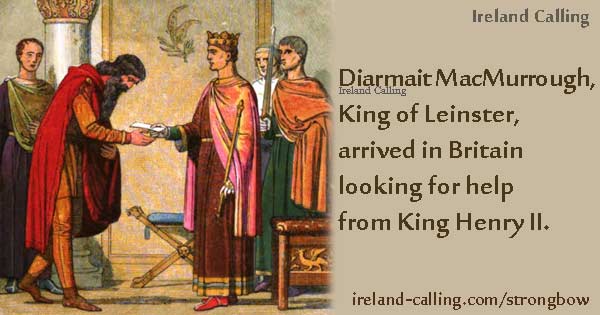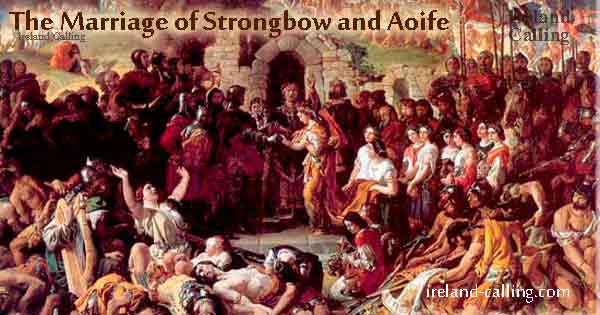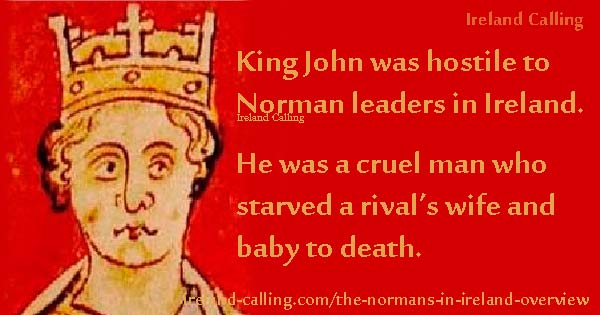In the 1160s, the King of Leinster abducted the wife of a minor neighbouring king. In the context of the constant squabbling that characterised Irish chieftains at that time, it was a relatively trivial matter.
In the end, however, it turned out to be one of the most significant events ever in the history of Ireland. The repercussions echo through the centuries to this day… for it led to the invasion of Ireland by the Normans – the most powerful fighting force in Europe at that time. After the Normans invaded, they established a foothold in the country that would develop into nearly 800 years of British rule.

Diarmait MacMurrough
The man who set in motion this momentous chain of events was Diarmait MacMurrough, King of Leinster. For reasons that are still unclear, he abducted the wife of King Tigernan O’Rourke of Bréifne, an area covering modern day Cavan, Leitrim and parts of Sligo. A furious Tigernan looked to the powerful King of Connacht, Rory O’Connor for help.

Rory and Tigernan defeated MacMurrough, who had to flee to Britain. MacMurrough was given permission from King Henry II to recruit help from his barons. He was able to assemble a formidable force that included The Earl of Pembroke, Richard Fitzgilbert de Clare, also known as Strongbow.

In 1169, MacMurrough and a small group of Norman forces headed to Ireland and reclaimed Leinster. The Normans were far better organised than the Irish. They fought as a unit whereas the Irish still preferred one on one combat.
Strongbow
Two years later, Strongbow also crossed the Irish Sea with several troops and helped MacMurrough to consolidate his power.
Strongbow married MacMurrough’s daughter, strengthening the alliance between the two men. Before long, Strongbow captured the towns of Dublin, Waterford and Wexford.

MacMurrough died in 1171 and Strongbow became King of Leinster. After he won a key battle against the King of Connacht he was summoned to a meeting with King Henry, who had become concerned by his increasing power.
They agreed that Strongbow would remain the King of Leinster but would answer to Henry. The towns of Dublin, Waterford and Wexford would all belong to the English crown.
As time went by, many Normans integrated with the native Irish and many alliances were formed between the two groups.
King John
In the thirteenth century, Henry’s son King John upset many Irish kings with his disrespectful behaviour but was even more hostile to Norman leaders in Ireland. He resented the amount of power they had. He was a cruel man who starved a rival’s wife and baby to death.

John built Dublin castle and under his reign many English laws and customs were implemented in Ireland. Dublin developed into a city of trade and manufacture. However, only Normans, and later Europeans were granted licences to practise trades, never the Irish.
Dublin castle was the centre of administration for the Normans in Ireland. The Normans established many towns such as Athenry, Drogheda, Kilkenny and Ross which became important trade centres.
Normans integrated with the Irish
By the 14th century, the Normans were finding it more difficult to retain control over the native Irish. Many Normans had integrated with the Irish and the power of the remaining Norman lords had decreased.
This was partly because each generation had less than the last as lords would typically share their estate between more than one son when they died. They often had to form alliances with Irish chieftains in order to maintain their power.
The Irish had also learned much from the Normans about military organisation and the kings and chieftains were constantly looking to expand their own influence.
Edward Bruce and the European famine
In 1315, Edward Bruce, the brother of Scottish King Robert Bruce, headed to Ireland with the intention of becoming king. He had the support of many Irish kings and marched down to Dublin to fight the Normans.
However, the Normans set fire to the suburbs outside the town walls and Edward’s troops turned back.
There was a terrible famine which meant that Edward’s troops were forced to take food from the Irish population they claimed to be liberating. Eventually Edward lost support as the Irish felt that the Scots were as bad as the English.
The famine was European wide and affected the Normans badly. They were heavily populated in the port towns around the country and relied on imported crops for their food. The rural Irish were less affected by the lack of imported crops.
Although the famine ended the people of Europe continued to be undernourished and were vulnerable to disease. In 1347 one of the most harrowing diseases of the age spread through the continent like wildfire – the bubonic plague.
The bubonic plague
The bubonic plague was also known as the Black Death and came from China or central Asia in 1147. It is estimated to have killed 25 million people as it travelled to the west, carried by rats on trade boats.
It reached Ireland in 1348 where it arrived in the port towns and, like the famine a few decades earlier, had a more devastating impact on the Normans than the Irish.
Eventually, as the Irish Kings became stronger, Norman influence and control over the country was reduced to a small but significant pocket in the East known as The Pale. The Pale consisted of Dublin and the surrounding areas.
Britain still had presence in Ireland
The remaining Normans outside The Pale intermarried and integrated with the Irish. However, while the Normans were all but gone, the British crown still had a presence in Ireland. That presence was to grow over the coming centuries until Ireland fell entirely under British rule.
It means that the Norman presence in Ireland, which began because an Irish king was having a little local difficulty, was to have a major effect on the country, changing it profoundly.
Ironically, the Normans were long gone as a force by the time the British had taken full control.
In fact, the Normans had been integrated into the Irish population and as British power increased, they became the oppressed rather than the oppressors.
It’s hard to imagine that the British would have kept out of Ireland had the Normans not gone there. It would have been too tempting a treat for a succession of English kings to ignore so a British invasion would probably have happened at some time or other. Nevertheless, it was the Normans who set the wheels in motion for British involvement, and that more than anything else, is their lasting legacy in Ireland.